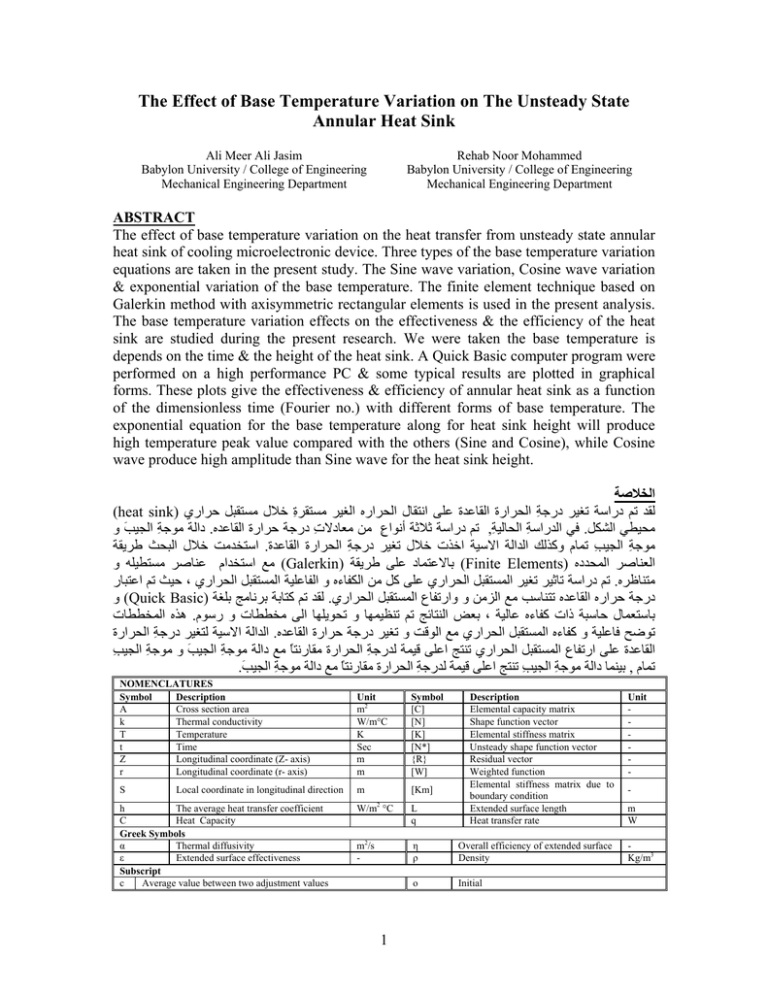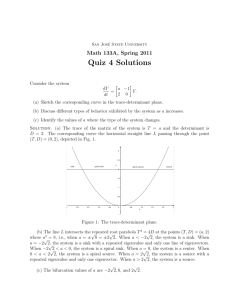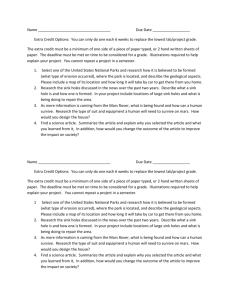The Effect of Base Temperature Variation on The Unsteady State
advertisement

The Effect of Base Temperature Variation on The Unsteady State
Annular Heat Sink
Ali Meer Ali Jasim
Babylon University / College of Engineering
Mechanical Engineering Department
Rehab Noor Mohammed
Babylon University / College of Engineering
Mechanical Engineering Department
ABSTRACT
The effect of base temperature variation on the heat transfer from unsteady state annular
heat sink of cooling microelectronic device. Three types of the base temperature variation
equations are taken in the present study. The Sine wave variation, Cosine wave variation
& exponential variation of the base temperature. The finite element technique based on
Galerkin method with axisymmetric rectangular elements is used in the present analysis.
The base temperature variation effects on the effectiveness & the efficiency of the heat
sink are studied during the present research. We were taken the base temperature is
depends on the time & the height of the heat sink. A Quick Basic computer program were
performed on a high performance PC & some typical results are plotted in graphical
forms. These plots give the effectiveness & efficiency of annular heat sink as a function
of the dimensionless time (Fourier no.) with different forms of base temperature. The
exponential equation for the base temperature along for heat sink height will produce
high temperature peak value compared with the others (Sine and Cosine), while Cosine
wave produce high amplitude than Sine wave for the heat sink height.
اﻟﺨﻼﺻﺔ
(heat sink) ﻟﻘﺪ ﺗﻢ دراﺳﺔ ﺗﻐﻴﺮ درﺟ ِﺔ اﻟﺤﺮارة اﻟﻘﺎﻋﺪة ﻋﻠﻰ اﻧﺘﻘﺎل اﻟﺤﺮارﻩ اﻟﻐﻴﺮ ﻣﺴﺘﻘﺮ ِة ﺧﻼل ﻣﺴﺘﻘﺒﻞ ﺣﺮاري
ﺐو
َ داﻟﺔ ﻣﻮﺟ ِﺔ اﻟﺠﻴ.ت درﺟﺔ ﺣﺮارة اﻟﻘﺎﻋﺪﻩ
ِ ع ﻣﻦ ﻣﻌﺎدﻻ
ِ ﺗﻢ دراﺳﺔ ﺛﻼﺛﺔ أﻧﻮا, ﻓﻲ اﻟﺪراﺳ ِﺔ اﻟﺤﺎﻟﻴ ِﺔ.ﻣﺤﻴﻄﻲ اﻟﺸﻜﻞ
اﺳﺘﺨﺪﻣﺖ ﺧﻼل اﻟﺒﺤﺚ ﻃﺮﻳﻘﺔ.ﺐ ﺗﻤﺎم وآﺬﻟﻚ اﻟﺪاﻟﺔ اﻻﺳﻴﺔ اﺧﺬت ﺧﻼل ﺗﻐﻴﺮ درﺟ ِﺔ اﻟﺤﺮارة اﻟﻘﺎﻋﺪة
ِ ﻣﻮﺟ ِﺔ اﻟﺠﻴ
( ﻣﻊ اﺳﺘﺨﺪام ﻋﻨﺎﺻﺮ ﻣﺴﺘﻄﻴﻠﻪ وGalerkin) ( ﺑﺎﻻﻋﺘﻤﺎد ﻋﻠﻰ ﻃﺮﻳﻘﺔFinite Elements) اﻟﻌﻨﺎﺻﺮ اﻟﻤﺤﺪدﻩ
ﺣﻴﺚ ﺗﻢ اﻋﺘﺒﺎر، ﺗﻢ دراﺳﺔ ﺗﺎﺛﻴﺮ ﺗﻐﻴﺮ اﻟﻤﺴﺘﻘﺒﻞ اﻟﺤﺮاري ﻋﻠﻰ آﻞ ﻣﻦ اﻟﻜﻔﺎءﻩ و اﻟﻔﺎﻋﻠﻴﺔ اﻟﻤﺴﺘﻘﺒﻞ اﻟﺤﺮاري.ﻣﺘﻨﺎﻇﺮﻩ
( وQuick Basic) ﻟﻘﺪ ﺗﻢ آﺘﺎﺑﺔ ﺑﺮﻧﺎﻣﺞ ﺑﻠﻐﺔ.درﺟﺔ ﺣﺮارﻩ اﻟﻘﺎﻋﺪﻩ ﺗﺘﻨﺎﺳﺐ ﻣﻊ اﻟﺰﻣﻦ و وارﺗﻔﺎع اﻟﻤﺴﺘﻘﺒﻞ اﻟﺤﺮاري
هﺬﻩ اﻟﻤﺨﻄﻄﺎت. ﺑﻌﺾ اﻟﻨﺘﺎﺋﺞ ﺗﻢ ﺗﻨﻈﻴﻤﻬﺎ و ﺗﺤﻮﻳﻠﻬﺎ اﻟﻰ ﻣﺨﻄﻄﺎت و رﺳﻮم، ﺑﺎﺳﺘﻌﻤﺎل ﺣﺎﺳﺒﺔ ذات آﻔﺎءﻩ ﻋﺎﻟﻴﺔ
اﻟﺪاﻟﺔ اﻻﺳﻴﺔ ﻟﺘﻐﻴﺮ درﺟ ِﺔ اﻟﺤﺮارة.ﺗﻮﺿﺢ ﻓﺎﻋﻠﻴﺔ و آﻔﺎءﻩ اﻟﻤﺴﺘﻘﺒﻞ اﻟﺤﺮاري ﻣﻊ اﻟﻮﻗﺖ و ﺗﻐﻴﺮ درﺟﺔ ﺣﺮارة اﻟﻘﺎﻋﺪﻩ
ﺐ
ِ ﺐ و ﻣﻮﺟ ِﺔ اﻟﺠﻴ
َ اﻟﻘﺎﻋﺪة ﻋﻠﻰ ارﺗﻔﺎع اﻟﻤﺴﺘﻘﺒﻞ اﻟﺤﺮاري ﺗﻨﺘﺞ اﻋﻠﻰ ﻗﻴﻤﺔ ﻟﺪرﺟ ِﺔ اﻟﺤﺮارة ﻣﻘﺎرﻧﺘًﺎ ﻣﻊ داﻟﺔ ﻣﻮﺟ ِﺔ اﻟﺠﻴ
.ﺐ
َ ﺐ ﺗﻨﺘﺞ اﻋﻠﻰ ﻗﻴﻤﺔ ﻟﺪرﺟ ِﺔ اﻟﺤﺮارة ﻣﻘﺎرﻧﺘًﺎ ﻣﻊ داﻟﺔ ﻣﻮﺟ ِﺔ اﻟﺠﻴ
ِ ﺑﻴﻨﻤﺎ داﻟﺔ ﻣﻮﺟ ِﺔ اﻟﺠﻴ, ﺗﻤﺎم
NOMENCLATURES
Symbol
Description
A
Cross section area
k
Thermal conductivity
T
Temperature
t
Time
Z
Longitudinal coordinate (Z- axis)
r
Longitudinal coordinate (r- axis)
S
Local coordinate in longitudinal direction
h
The average heat transfer coefficient
C
Heat Capacity
Greek Symbols
α
Thermal diffusivity
ε
Extended surface effectiveness
Subscript
c
Average value between two adjustment values
Unit
m2
W/m°C
K
Sec
m
m
m
[Km]
W/m2 °C
L
q
Description
Elemental capacity matrix
Shape function vector
Elemental stiffness matrix
Unsteady shape function vector
Residual vector
Weighted function
Elemental stiffness matrix due to
boundary condition
Extended surface length
Heat transfer rate
m2/s
-
η
ρ
Overall efficiency of extended surface
Density
o
Initial
1
Symbol
[C]
[N]
[K]
[N*]
{R}
[W]
Unit
m
W
Kg/m3
INTRODUCTION
Annular heat sinks are used extensively in heat exchanger devices to increase the heat
transfer rate from heat source for a given temperature difference or to decrease the
temperature difference between the heat source & the heat sink for a given heat flow rate.
The interesting of used annular heat sinks in many thermal engineering field, such as
cooling components in microelectronic package, air conditioning heat exchanger, where
using heat sink, thermal analysts have succeeded in designing more compact & efficient
heat transfer system. A schematic of the annular heat sink that used in the present study is
shown in figure (1) in horizontal & vertical orientation. The heat sink consists of (Nf)
identical fins with a centrally located circular support cylinder. Each fin has a fin
thickness (tf), an outer radius (Ro), and an inner radius (Ri). Adjacent fins are separated
by a distance (bf) & the overall length of the heat sink is (L).
Convection heat transfer from annular heat sinks can be found in the open literature.
Several solutions to the problem of steady condition within in annular fin of constant
thickness have been presented [1] & [2]. Edwards and Chaddock, [3], discussed the heat
transfer from annular heat sink experimentally. M.M.Yovanovich [4], used a simplified
solution for annular fin of constant thickness with boundary conditions of third kind
(Robin condition) applied to the fin base, sides & end. Sushanta K. Mitra, [5], developed
a simplified & accurate technique by means of resistance method for determining the fin
resistance of constant thickness annular fin with base contact resistance & end cooling.
C.S.Wang, [6], studied the natural convection heat transfer from horizontal isothermal
annular heat sink, he treat the inner & outer surface separately and establish the general
model which account for the effects of all surfaces of the heat sink..
The objective of the present research is study the heat transfer from annular heat sink of
cooling microelectronic system by using finite element techniques. The variation of base
temperature is studied here & we assumed base temperature is varied with time & the
heat sink height. Then we checked the traditional assumption of the heat sink of constant
base temperature.
Ro
Hf
tb
Ri
tf
bf
L
Processor
Figure (1): the annular heat sink for PC
2
MATHEMATICAL MODELLING
Consider constant thickness annular heat sink, as shown schematically in figure (1) .The
analysis is based the following assumptions:
All the physical properties for the annular heat sink materials are assumed to be constant.
There is a perfect contact between the wall and the extended surfaces.
The environment heat transfer coefficient (h) is proportional with the film temperature
(the average temperature between the fluid & surface temperatures).
The differential equation for the transient temperature distribution is formulated from a
consideration of heat balance over the differential element (∆z, ∆r), taken into account
the assumptions of the problem. Hence, the differential equation for a two dimensional
unsteady-state (transient) heat flows can be written as following:
∂ 2 T 1 ∂ 2 (rT) 1 ∂T
+
=
…………………………………...………………...………..(1)
∂Z 2 r ∂r 2
α ∂t
The Initial & boundary conditions for the case study as following:
The initial condition is given by
Tinitial = T(r, Z,0) = Tbase
at
t = 0 ………….…....……...……….……(2)
Because of symmetry of boundary conditions of the third kind which are imposed over
the fin base, sides & end , then the boundary conditions as following:
∂T
At Z = 0 & (Ri - tb) < r < Ri k
= 0 ………………..…….….………………….(3)
∂Z
∂T
At Z = L & (Ri - tb) < r < Ri − k
= h (T − Tf ) …..………………….…....…....(4)
∂Z
∂T
At r = Ro & 0 < Z < L (fin tip) − k
= h (T − Tf ) . …..……………………..……(5)
∂r
∂T
= h (T − Tf ) …..(6)
At Ri < r < Ro & 0 < Z < L (upper & lower surface of fins) − k
∂r
∂T
At r = Ri & 0 < Z < L (space between fins) − k
= h (Tb − Tf ) ……...……........(7)
∂r
….……..………………………….(8)
At r = Ri & 0 < Z < L T = Tbase
In our study, we have taken the Tbase variable as following, [7]:
2π
⎧
⎫
⎪Tbase = Tb + (Tb − Tf ) Sin ( L Z) Cos(ω t ) ⎪
⎪
⎪
2π
⎪
⎪
⎨Tbase = Tb + (Tb − Tf ) Cos( Z) Cos(ω t )⎬ ………..……………………………….(9)
L
⎪
⎪
Z
⎪
⎪
⎪Tbase = Tb + (Tb − Tf ) Exp( L ) Cos(ω t ) ⎪
⎩
⎭
GALERKIN FINITE ELEMENT TECHNIQUES
To calculate the efficiency & the effectiveness, firstly, we must calculate the temperature
distribution throughout the annular heat sink. The weighted residual finite element based
on Galerkin method with axisymmetric rectangular elements had been used to solve the
governing differential equations that mentioned previously compound with the initial &
boundary conditions.
3
The solution of the set of the differential equations and boundary conditions established
is approximated by following integral, [8]
∫ Wi Rdv = 0 ……………………………………………………..……...………….…(10)
v
⎛ ∂ 2 T 1 ∂ 2 (rT) ⎞ ∂T
⎟−
R = α⎜ 2 +
≠ 0 …………….......................................................…(11)
2
⎟ ∂t
⎜ ∂Z
r
r
∂
⎠
⎝
It is noted the above equation is not equal zero, since the approximate solution does not
satisfy Fourier equation exactly
The temperature is approximated by a continuous function of Z & r. After some
mathematical manipulation, it can show the temperature in a given elements as [9]:
T
T ( e ) = {N} {Tn }
…..…………………...………………………..…………………..(12)
T = N i Ti + N jTj + N k Tk + N m Tm …… ………………………..……………………….(13)
Where the Tn is the nodal temperatures vector including the temperatures at the nodes
attached to the element, & {N}T is the row factor of the element shape functions.
Where the axisymmetric rectangular elements shape function (figure (2)) as following:
1
⎧
(R j − r ) (Zm - Z)⎫⎪
N
=
i
⎪
4ab
⎪
⎪
1
⎪
(r − R i )(Z m - Z)⎪⎪
⎪N j =
⎪
⎪
4ab
⎨
⎬ …………………….……………….…………………(14)
⎪ N = 1 (r − R )(Z - Z ) ⎪
i
i
⎪ k 4ab
⎪
⎪
⎪
⎪ N = 1 (R − r ) (Z - Z )⎪
i
⎪⎩ m 4ab j
⎪⎭
Z
m
k
i
j
Zm
Zi
r
Ri
Rj
Figure (2): axisymmetric rectangular element
The residual vector of Galerkin finite element as following:
⎡ ⎛ ∂ 2 T 1 ∂ 2 (rT) ⎞ ∂T ⎤
⎟ − ⎥ dA ………….……..............................…(15)
R ( e ) = − ∫ [ N]T ⎢α⎜⎜ 2 +
r ∂r 2 ⎟⎠ ∂t ⎦
A
⎣ ⎝ ∂Z
{ }
4
{R } = − ∫ [ N] α⎛⎜⎜ ∂∂ZT + 1r ∂ ∂(rrT) ⎞⎟⎟ dA + − ∫ [ N]
∂T
dA ……………….................…(16)
∂t
A
A
⎠
⎝
With the substitution of eq. (3) in eq. (1) and application the Galerkin method weighted
residual statement can be rewritten as:
⎧ ∂{T}⎫
..……….…...………………………………………..(17)
[C]⎨
⎬ + [k ]{T}+ {F} = 0
⎩ ∂t ⎭
In the above equation, the element distribution of the global capacitance matrix [C], of
the global conductivity matrix [k], and the global force vector {f} are:
…….…………………...…………...……………..(18)
[C( e ) ] = ∫ ρCp r[ N][ N]T d ( vol)
(e)
2
T
2
2
T
2
Vol
[k ] = ∫ [B][D][B] d(vol) + ∫ h [N][N] d(surf ) ..…………………………..(19)
{f }= ∫ hT [N] d(surf ) ..……………………………………..…………..(20)
(e)
T
Vol
T
Surf
(e)
T
Surf
f
Where
⎡ ∂[ N] ⎤
⎢ ∂Z ⎥
0⎤
⎡k
⎥
[B] = ⎢⎢
And
[D] = ⎢ zz
⎥ …………………….………..…(21)
⎥
⎣ 0 k rr ⎦
∂
[
N
]
⎢
⎥
⎢⎣ ∂r ⎥⎦
K ( e ) = K (Me ) {r} + K s( e ) {r} ..………………………..….……………….….……..…(22)
Where
⎡ 2 - 2 - 1 1⎤
⎡ 2 1 - 1 - 2⎤
⎢- 2 2 1 - 1⎥
⎢
⎥
2πrak ⎢ 1 2 - 2 - 1⎥
2πrak ⎢
(e)
⎥
+
KM =
……………………..(23)
1⎥
6 b ⎢- 1 - 2 2
6 b ⎢- 1 1 2 - 2 ⎥
⎢
⎥
⎢
⎥
⎣ 1 - 1 - 2 2⎦
⎣- 2 - 1 1 2 ⎦
⎡2 1 0 0 ⎤
⎢
⎥
2π h Lij ⎢1 2 0 0 ⎥
(e)
Ks =
…………..………………………………………..(24)
6 ⎢0 0 0 0 ⎥
⎢
⎥
⎣0 0 0 0 ⎦
⎡ Ri ⎤
⎢R ⎥
{r} = ⎢ j ⎥ ………………………………..………..………………………………..(25)
⎢Rk ⎥
⎢ ⎥
⎣R m ⎦
⎡2 R i + R j ⎤
⎢
⎥
2π hTf Lij ⎢R i + 2 R j ⎥
(e)
fs =
⎢
⎥ …………..……….…………………….………...(26)
0
6
⎢
⎥
⎢
0 ⎥⎦
⎣
[ ] [ ]
[ ]
[ ]
[ ]
{ }
5
⎡1 0 0 0⎤
2πraρC p ⎢0 1 0 0⎥
⎢
⎥ …………….…………………………………...……(27)
c(e) =
⎢0 0 1 0 ⎥
4b
⎢
⎥
⎣0 0 0 1⎦
Where, the ( Lij ) is the length of the respective side of the element that subject to the
boundary condition & the ( r ) is the average radius of the elements . There are three other
(e)
results of [K s( e ) ]& fs , one for each element side.
The linear first- order differential equations in the time domain will produce in finite
element solution. These equations must be solved before the variation of (T) in space and
time. A several procedures can be used for numerically solving of the eq. (25).
Give a function T(t) and the interval [a, b], we can use the mean value theorem for
differentiation to develop an equation for T(t). Then the final equation for temperature
with time is:
{T} = (1 − θ){T}a + θ {T}b ………………………………………………….………...(28)
And after substitution the above equation in equation (13), will produce:
([C] + θ ∆t [k ]){T}t + ∆t = ([C] − θ ∆t [k ]){T}t + ((1 − θ){f }t + θ {f }t + ∆t ) …………………(29)
In above equation, θ = 0; ½ & 1 corresponding to the explicit, Crank-Nicholson and
purely implicit solution to the system, in our study we take (θ=1/2) (Crank Nicholson).
The convective heat transfer coefficient formula in the present study as following [10]:
h r = 7.2 Vr0.78 …………………………………………………………………………(30)
Where Vr is the air velocity along the plate,
Since mass velocity is the fundamental variable in forced-convection equations, Schack
recommends that the velocity should be corrected according to the ideal gas law for
temperatures. The velocity along the plate can be expressed by
&
m
V=
…………………………………………………………………………..(31)
A flow ρ
Substituting Eq. 31 into Eq. 30 gives the convective heat transfer coefficient as
[ ]
{ }
0.78
⎛m
& R Tfilm ⎞
⎟⎟ ………………………………………………………..……….(32)
h = 7.2⎜⎜
⎝ A flow ρ ⎠
Where Tfilm is the film temperature in Kelvin
The total heat lost from the heat sink heat sink equal to the summation of heat lost from
each element which subjected to the boundary condition (air) as following:
BC
q ct = ∑ h i A i (Ti − Tf )
……….................................................................................... (33)
Ac = 2 π i ∆r . ∆Z ……………………………………………………………….…...(34)
The ratio of the actual heat lost from heat sink to the heat lost from the bared cylinder
surface without fins is called heat sink effectiveness, it is calculated as following:
i =1
BC
q ct = ∑ h i A i (Ti − Tf )
i =1
………………..……………………………..….……...(35)
Ao = 2 π ri . L ……………………………………………………………………...(36)
6
0.78
⎛m
& R Tav ⎞
⎟⎟ ……………………………………………………………….(37)
h o = 7.2⎜⎜
ρ
A
⎝ flow ⎠
Then, the heat sink effectiveness
BC
ε=
∑ h i i ∆r ∆Z (Ti − Tf )
i =1
h o ri L (Tbase − Tf )
……………………………………..…..……...(38)
The ratio of actual heat transfer lost by heat sink to the heat lost from the same heat sink
but it’s surfaces temperature are constant and equal to base temperature, as following
BC
q fb = ∑ h b A i (Tb − Tf )
c =1
……………………………………...……..…..……...(39)
Then, the heat sink efficiency
BC
η=
∑ h i i ∆r ∆Z (Ti − Tf )
i =1
BC
∑ h b i ∆r ∆Z (Tb − Tf )
………………………..……………………..…..……...(40)
i =1
The nodals temperature are assumed to be converged to the steady-state values when the
difference of the nodals temperature between two alternative time steps (n) and (n+1)
satisfies the equation
Error = Ti j+1 − Ti j / Ti j ≤ 10−6 …………………..……………………..…..……...(41)
(
)
RESULTS & DISCUSSION
Before the discussion of the results, we must check the accuracy of the present program
& analysis, and then we compared the results of the present program with the two
dimensional heat transfer from annular fins, [4] in figure (3). For two cases, when the
heat from the extended tip insulated & non-insulated. From this figure, we can observe a
good accuracy in our program & technique.
Also, we can showed the variation of the heat sink efficiency with the Biot number, the
efficiency decreased as the Biot number increased due to increasing of the heat transfer
coefficient, the increasing of heat transfer coefficient will increase the heat transfer
removed from the heat sink & then reduce the temperature difference between the surface
& the environment temperatures with constant base temperature.
Figures (4) & (5), showed the efficiency & the effectiveness of the heat sink at a constant
Biot number & variable base temperature. Because of we took the initial temperature
equal to the base temperature in our case study, the efficiency & the effectiveness of heat
sink start from the high value & then its decreased as the time (Fourier number) increased
to reach the steady state value, after this value no change will occurs in the efficiency &
the effectiveness of the heat sink with time (Fourier umber) increased. In our steady we
took three cases for the variation of the base temperature with engine overall length
(Sine, Cosine, and Exponential) & with time effect took the cosine wave form. We can
note the exponential form for engine length will produce high temperature peak value
compared with the others, while cosine wave produce high amplitude than sine wave for
the engine length.
In order to check the effect of the variation of the base temperature on the efficiency &
effectiveness of the annular heat sink, we took different forms for base temperature.
7
As shown in figures (6) & (7), the periodic cosine time variation is replaced with sine
time variation (see the legends of figures (6) & (7)), we can show nearly the same
behaviors of the previous figures (4) & (5), also the base temperature for the exponential
form will produce high amplitude.
For special case, where the base temperature of the annular heat sink changed
exponentially with time (see the legends of figures (8) & (9)), we can note the efficiency
& the effectiveness for this case not reach to the steady state value & the efficiency
reduced than steady state value as the time (Fourier number) increased while the
effectiveness of the annular heat sink firstly decreased to reach the steady state value &
then increased sharply after this value, this behavior due to the base temperature reach to
the large value abnormal distribution as the time increased.
CONCLUSION
The unsteady heat transfer from annular heat sink of cooling microelectronic device are
solved numerically here by using finite elements (Galerkin method) with axisymmetric
rectangular elements. The results of the present work showed the large effect of the base
temperature on the efficiency & the effectiveness of annular heat sink. The exponential
time change of base temperature is not produced & reach to the steady state value, and
the exponential engine height change of base temperature for other two cases will
produce high temperature peak & variation in the base temperature..
REFERENCES
1- Harper, D.R. and Brown, W.B., “Mathematical Equations for Heat Conduction in the Fins of Air
Cooled Engine”, NACA report No.158, 1922, cited from [ ].
2- Carrier, W.H. and Anderson, S.W., “The resistance to Heat Flow Through Finned Tubing”, Heating,
Piping, and Air Conditioning, Vol. 10, 1944, PP. (304 – 320).
3- Edward, J. A., and Chaddock, J.B., “An Experimental Investigation of Radiation and Free
Convection Heat Transfer from Cylindrical Disk Extended Surfaces”, Trans. ASHRAE, Vol. 169,
1963, PP. (313 – 316).
4- Yovanovich, M.M. and et al, “Simplified Solutions to Circular Annular Fins with Contact
Resistance & End Cooling”, Journal of Thermodynamics, Vol. 2, 1998, PP. (152 – 158).
5- Mitra, S.K, and Yovanovich, M.M., “Resistance Approach for Annular Fins With Contact
Conductance and End Cooling”, 40th AIAA Aerospace Sciences Meeting & Exhibits, 14 January, 2002,
PP.(1-5) (1984).
6- Wang, C.S. and et al, “Modeling Natural Convection from Horizontal Isothermal Annular Heat
Sink”, Trans. ASME , Vol. 121, 1999, PP. (44 – 49).
7- Look, J.r. , “Two- Dimensional Fins With Non-Constant Root Temperature”, Int. J. Heat Mass
Transfer , Vol. 32, 1989, PP. (977 – 980).
8- “Semi- Explicit Method for Wall temperature Linked Equations (SEWTLE)”, SSME, 2002, PP. (1
– 35).
9- - Segerlind, L.J, “Applied of Finite Element”, John Wiley and Sons, (1984).
10- Wetter, M., “Simulation Model, Finned Water to Air Coil without Condensation”, 1998, PP. (2 –
14).
8
List of Figures
1.00
Comparison
Present Study
Yovanovich[4]
The Efficiency Of the Heat Sink
Present Study (inslulated tip
Yovanovich[4] (insluated tip)
0.90
0.80
0.70
0
1
2
3
4
5
The Biot Number
Figure (3): show the comparison for two cases extended insulated tip & non insulated tip
1.0
The Viaration of Base Temperature
T = Tb+(Tb-Tf) Sin(ay) Cos(wt)
T = Tb+(Tb-Tf) Cos(ay) Cos(wt)
0.9
T = Tb+(Tb-Tf) Exp(ay) Cos(wt)
The Overall Effeciency
T = Tb
0.8
0.7
0.6
0.5
0.4
0
2
4
6
8
10
12
14
16
18
20
The Dimensionless Time
Figure (4): show the efficiency against the dimensionless time
9
40
The Viaration of Base Temperature
T = Tb+(Tb-Tf) Sin(ay) Cos(wt)
35
T = Tb+(Tb-Tf) Cos(ay) Cos(wt)
The Overall Effectiveness (Performance)
T = Tb+(Tb-Tf) Exp(ay) Cos(wt)
T = Tb
30
25
20
15
10
5
0
2
4
6
8
10
12
The Dimensionless Time
14
16
18
20
Figure (5): show the effectiveness against the dimensionless time
1.0
The Variation of Base temperature
T=Tb+(Tb-Tf) Sin(ay) Sin(wt)
T=Tb+(Tb-Tf) Cos(ay) Sin(wt)
0.9
T=Tb+(Tb-Tf) Exp(ay) Sin(wt)
The Overall Efficiency
T=Tb
0.8
0.7
0.6
0.5
0.4
0
2
4
6
8
10
12
The Dimensionless Time
14
16
18
20
Figure (6): show the efficiency against the dimensionless time
10
36
The Variation of Base temperature
T=Tb+(Tb-Tf) Sin(ay) Sin(wt)
32
The Overall Effectiveness (Performance)
T=Tb+(Tb-Tf) Cos(ay) Sin(wt)
T=Tb+(Tb-Tf) Exp(ay) Sin(wt)
28
T=Tb
24
20
16
12
8
4
0
2
4
6
8
10
12
The Dimensionless Time
14
16
18
20
Figure (7): show the effectiveness against the dimensionless time
1.0
The Variation of Base Temperature
T=Tb+(Tb-Tf) Sin(ay) Exp(wt)
T=Tb+(Tb-Tf) Cos(ay) Exp(wt)
0.8
T=Tb+(Tb-Tf) Exp(ay) Exp(wt)
The Overall Efficiency
T=Tb
0.6
0.4
0.2
0.0
0
2
4
6
The Dimesionless Time
8
10
Figure (8): show the efficiency against the dimensionless time
11
40
The Variation of Base Temperature
T=Tb+(Tb-Tf) Sin(aZ) Exp(wt)
T=Tb+(Tb-Tf) Cos(aZ) Exp(wt)
35
The Overall Effectiveness (Performance)
T=Tb+(Tb-Tf) Exp(Z/ L) Exp(wt)
T=Tb
30
25
20
15
10
0
2
4
6
The Dimesionless Time
8
10
Figure (9): show the effectiveness against the dimensionless time
12




